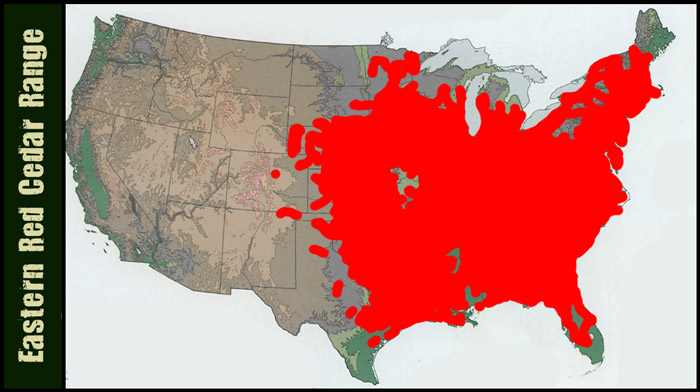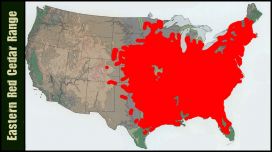The Eastern Red Cedar
Juniperus virginiana
The Eastern Red Cedar is has a considerable history that few know about. It’s also a bit of a misnamed plant; it isn’t even a cedar. It’s a juniper. The name cedar goes all the way back to the first writings of the discovery of the new world in Virginia. They wrote back and described this tree as the most magnificent of all the cedars. Since then the name has lived on, even though botanical experts actually call it a juniper. Thus another names for the plant is the Eastern Juniper.
Growth Forms
The Eastern Red Cedar is a scraggly type tree that has a few different growth forms. In the east, the plant is often tall and erect. In the western part of it’s range, the tree tends to be almost shrub-like.
Identifying this plant
If you’re in the native range of this plant, there are a few things you can look for that make it unique from other conifers that look somewhat similar.
Leaves
The leaves are of two types: Sharp, spreading needle-like juvenile leaves, 5 to 10 cm long, and tightly adpressed scale-like adult leaves, 2 to 4 mm long. They are arranged in opposite decussate pairs or occasionally whorls of three. The photo below shows an adult male tree’s leaves.
Trunk
The bark on the trunk is reddish-brown, fibrous, and peels off in narrow strips.
Berries
Only female trees produce the tiny blue berries. Squeeze them between your fingers and you’ll find a nice little seed. However, juniper “berries” are not true berries. They are cones with unusually fleshy and merged scales.
Where does the eastern red cedar grow?
Natively Juniperus virginiana can be found almost exclusively in the eastern US. The map below was taken from specific county data from Pollenlibrary.com. Individual counties recorded the presence or absence of the tree and marked them on the map. We then took this map and made it graphical. Thus, this map should be one of the most accurate, in terms of current range of the tree.
History
Pencils!
Back in the day, the Red cedar was the choice for pencils. The wood was great to work with as it was soft and aromatic. The only problem was that they cut down all the red cedar trees in the US by about 1920. Now, they’ve moved on to other trees (and synthetic materials).
The Apple Orchard Controversy
Red Cedars are hosts for a disease that inflicts apple orchards.
The Flavor of Gin
You might not be familiar with many recipes that call for juniper berries spices. However, if you’ve ever had gin, then you’re familiar with the taste as pungent and piney. The Juniper berry is what gives gin it’s flavor. However, it should be noted that this particular species of Juniper isn’t where most of the spice comes from; the tastiest juniper berries are said to come from Macedonia and Albania.
Related Topics
The Eastern Red Cedar is has a considerable history that few know about. It’s also a bit of a misnamed plant; it isn’t even a cedar. It’s a juniper. The name cedar goes all the way back to the first writings of the discovery of the new world in Virginia. They wrote back and described this tree as the most magnificent of all the cedars. Since then the name has lived on, even though botanical experts actually call it a juniper. Thus another names for the plant is the Eastern Juniper.
Growth Forms
The Eastern Red Cedar is a scraggly type tree that has a few different growth forms. In the east, the plant is often tall and erect. In the western part of it’s range, the tree tends to be almost shrub-like.
Identifying this plant
If you’re in the native range of this plant, there are a few things you can look for that make it unique from other conifers that look somewhat similar.
Leaves
The leaves are of two types: Sharp, spreading needle-like juvenile leaves, 5 to 10 cm long, and tightly adpressed scale-like adult leaves, 2 to 4 mm long. They are arranged in opposite decussate pairs or occasionally whorls of three. The photo below shows an adult male tree’s leaves.
Trunk
The bark on the trunk is reddish-brown, fibrous, and peels off in narrow strips.
Berries
Only female trees produce the tiny blue berries. Squeeze them between your fingers and you’ll find a nice little seed. However, juniper “berries” are not true berries. They are cones with unusually fleshy and merged scales.
Where does the eastern red cedar grow?
Natively Juniperus virginiana can be found almost exclusively in the eastern US. The map below was taken from specific county data from Pollenlibrary.com. Individual counties recorded the presence or absence of the tree and marked them on the map. We then took this map and made it graphical. Thus, this map should be one of the most accurate, in terms of current range of the tree.
History
Pencils!
Back in the day, the Red cedar was the choice for pencils. The wood was great to work with as it was soft and aromatic. The only problem was that they cut down all the red cedar trees in the US by about 1920. Now, they’ve moved on to other trees (and synthetic materials).
The Apple Orchard Controversy
Red Cedars are hosts for a disease that inflicts apple orchards.
The Flavor of Gin
You might not be familiar with many recipes that call for juniper berries spices. However, if you’ve ever had gin, then you’re familiar with the taste as pungent and piney. The Juniper berry is what gives gin it’s flavor. However, it should be noted that this particular species of Juniper isn’t where most of the spice comes from; the tastiest juniper berries are said to come from Macedonia and Albania.






































































































